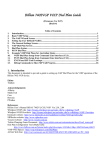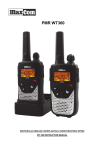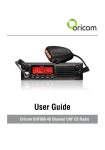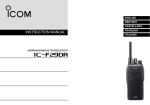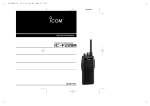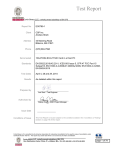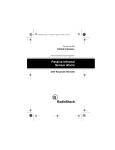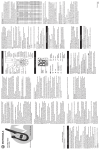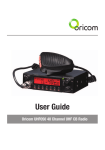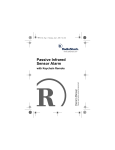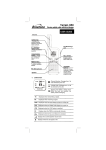Download Oricom UHF2100 Radio User Manual
Transcript
Operating Instructions UHF2100 40 Channel UHF 2 Way Citizen Band Radio Table of contents Safety Information and Warnings.................................... 4 Getting Started............................................................... 6 Oricom UHF2100 instructions....................................... 10 Operation...................................................................... 11 Specifications............................................................... 20 Warranty information (Australia).................................... 22 Customer support......................................................... 23 3 Safety Information and Warnings Safety Information and Warnings CAUTION WARNING 4 Damaged Antenna Do not use any radio that has a damaged antenna. If a damaged antenna comes in contact with the skin, a minor burn may result. Batteries All batteries can cause property damage and/ or bodily injury such as burns if conductive material such as jewelry, keys, or beaded chains touches exposed terminals. The material may complete an electrical circuit (short circuit) and become quite hot. Exercise care in handling any charged battery, particularly when placing it inside a pocket, purse, or other container with metal objects. For Vehicles with an Air Bag Do not place your radio in the area over an air bag or in the air bag deployment area. Air bags inflate with great force. If a radio is placed in the air bag deployment area and the air bag inflates, the radio may be propelled with great force and cause serious injury to the occupants of the vehicle. Potentially Explosive Atmospheres Turn your radio OFF when in any area with a potentially explosive atmosphere, unless it is a type especially qualified for such use (for example, Factory Mutual Approved). Sparks in such areas could cause an explosion or fire resulting in injury or even death. Safety Information and Warnings WARNING Batteries Do not replace or charge batteries in a potentially explosive atmosphere. Contact sparking may occur while installing or removing batteries and cause an explosion. Blasting Caps and Areas To avoid possible interference with blasting operations, turn your radio OFF near electrical blasting caps or in a “blasting area” or in areas posted: “Turn off the two way radio.” Obey all signs and instructions. NOTE: Areas with potentially explosive atmospheres are often, but not always clearly marked. They include fueling areas such as below deck on boats; fuel or chemical transfer or storage facilities; areas where the air contains chemicals or particles, such as grain, dust, or metal powders; and any other area where you would normally be advised to turn off your vehicle engine. Cleaning and Care To clean your radio, use a soft cloth dampened with water. Do not use cleaners or solvent, which may cause damage that may not be covered by guarantee. 5 Getting Started Installation Removing the Belt Clip Pull the Belt Clip latch forward (away from the unit) While pulling the Belt Clip latch, push up the Belt Clip as shown in Figure1. Belt Clip latch Installing the Belt Clip Slide the Belt clip into the slot as shown in Figure2. A “click” indicates the Belt clip is locked into position. Installing the Batteries Figure 3 Figure 1 Figure 2 Figure 4 Caution: O bserve the proper battery polarity orientation when installing batteries. Incorrect positioning can damage both the batteries and the unit. a. Slide down the Battery Compartment Cover. b. Install the rechargeable batteries by following the orientation as shown in Figure 3 (the arrow is showing and pointing upward.) c. Replace the Battery Compartment Cover. See Figure 4. 6 Getting Started Important Read these Safety Warnings before you charge the batteries. When placing the radio in the charger, use only the power supplies listed in the user instructions supplied with the unit. Don’t try to recharge non-rechargeable batteries. Make sure the battery compartment cover is securely locked in place when you are charging the batteries. Dispose of used batteries safely and in a way that will not harm the environment- never try to burn them or put them anywhere, they could get burnt or punctured. Don’t leave dead batteries in your radio. They might leak if you do. Charging the batteries Insert the small plug on the end of the mains adaptor into the Power-in connection jack at the back of the desktop charger. Plug the mains adaptor into a 240V AC, 50Hz main socket with the switch on the socket set to OFF. a. Switch ON the main socket. b. Place the radio in the charge cradle in an upright position The Charge LED indicators will light up. It takes about 10 hours to fully charge the batteries if they are completely run down. New batteries take up to 14 hours to fully charged. Switched Mains Power Outlet 7 Getting Started Battery meter The battery meter is located in the left corner of the LCD screen. It appears like a battery with three bars inside. These indicate the amount of power available. When the battery level reaches it minimum level, the unit will emit two beep tones and automatically it will power off. Your UHF2100 can detect the battery charge in 4 levels; Battery charge at high level. Battery charge at medium level. Battery charge at low level. At this level, the radio will emit a “beep” sound for every 10 seconds in standby mode. TIP: At this stage, you need to recharge the unit at once, otherwise the battery will run down totally. Battery charge at very low level. When the battery level reaches its minimum level, the unit will emit two beep tones and automatically turn off the power. Important: You need to charge the unit for 10-14 hours. CAUTION: R isk of explosion if battery is replaced by an incorrect type. Dispose of used batteries according to the instructions. Battery life Your radio has a built in power saver to make the batteries last longer. But when you are not using the units, turn them OFF to conserve battery power. 8 Getting Started Operation Transmitting range The talk range depends on the environment and terrain. It will reach (up to about 10km) in wide open spaces, without obstructions such as hills or buildings. Don’t try to use two radio units which are less than 1.5m (5feet) apart. Otherwise, you may experience interference. Important safety warning: To reduce radio frequency exposure when you are using your units, hold the unit at least 5cm (2 inches) away from your face. Never use your radio outdoors during a thunderstorm. Don’t use the radio in the rain. If your radio gets wet, turn it off and remove the battery. Dry the battery compartment and leave the cover off for a few hours. Don’t use the unit until it is completely dry. Keep the radio out of reach of babies and young children. The operation of this radio in Australia and New Zealand is subject to conditions in the following licenses. In Australia the ACMA Radio communications (Citizen Band Radio Stations) In New Zealand the General User Radio License for Citizen Band Radio. 9 Oricom UHF2100 instructions Oricom UHF2100 instructions Antenna LCD Screen - Displays the current channel selection and other radio symbols. PTT (PUSH to TALK) button - Press and hold to transmit. UP/DOWN Buttons - Press to change channels, volume, and to select settings during programming. Speaker PWR/VOL Switch - Rotate clockwise/ counter clockwise to turn the unit ON or OFF. Ear/Mic/Charge jack CALL button - Press to send Ringing tone to other radio units. MENU Button - Press to change To switch between Modes MIC (Microphone) LCD Screen RPT 10 hannel Number. Changes from 1 to 40 as C selected by the user. CTCSS Code. Changes from 1 to 38 as selected by the user. Displays the Battery change level. When the bars are reduced, the battery needs to recharge. Displayed when transmitting a signal. Displayed when receiving a signal. Displayed when the Dual Watch function is turned ON. Displayed when the Digital Code System is turned On. Displayed when the VOX feature is enabled. Displayed when the radio is doing scan. Displayed when the repeater function is activated. Displayed when the call signal is ON. Displayed when the vibrator function is activated. Displayed when the Key Lock feature is activated. Operation Operation Turning the Unit ON/OFF To Turn ON; a. R otate the POWER/VOL button clockwise until the LCD screen turns ON and displays the current channel. To switch OFF; b. R otate the POWER/VOL button counter clockwise until the LCD screen turns blank. Note: Every time you rotate the Power/Vol button to turn ON, the volume will also open. The volume level will increase or decrease by rotating the Power/Vol button. Changing Channels The UHF2100 has 40 available channels, to communicate with other radio’s, it must have your radio tuned to the same channel. a. P ress the MENU button once, the current channel number flashes on the LCD Screen. b. P ress the UP or DOWN button to select the desired channel. The channel changes from 1 to 40, or vice versa. c. P ress the PTT button to confirm the channel setting. Important Notes Channels 5 and 35 (paired for Duplex repeaters) are reserved as emergency channels and should be used only in an emergency. Channel 11 is a calling channel generally used to call others and channel 40 is the customary road vehicle channel. Once contact is established on the calling channel, both stations should move to another unused "SIMPLEX" channel to allow others to use the calling channel. Channels 22 and 23 are for Telemetry and Telecommand use, voice communications are not allowed on these channels by law. Channels marked Duplex are reserved for repeater use in some areas. 11 Operation These are paired with higher channels as output/input (1/31, 2/32, etc.) Check for local repeater activity before using these channels in Simplex mode to avoid interference. Channels 9 and above are the best choices for general use in Simplex mode. You can find more information about channels and frequencies by visiting the Web site http://www.acma.gov.au/ACMAINTER.786700 :STANDARD:1627891715:pc=PC_1265#Repeaters Note: Refer to the “Channel Table” section of this Owner’s Manual for detailed frequency listing. Setting the CTCSS sub-channel Each channel has 38 sub-channels to let you set up group of users within the same channel for more private communication. If you have set the sub-channel, you can only communicate with other radio users tuned to the same channel and sub-channel. To turn the sub-channel function off, simply set the subchannel to 0 (zero). You can then communicate with other radio’s setting to the same channel who also turns off the sub-channel operation (or whose unit does not have the sub-channel feature). a. P ress the MENU button twice, the current CTCSS subchannel number flashes on the LCD screen. b. P ress the UP or DOWN button to select one of the 38 CTCSS sub-channels. c. Press the PTT button to confirm the CTCSS sub-channel setting. 12 Operation SETTING THE DCS ADVANCED DIGITAL CODE. Each channel also has 83 digital codes to let you set a group of users for more secured private communication. a. P ress the MENU button 3 times. DCS code is blinking on the LCD screen. b. Press the UP or DOWN button to select the desired DCS code. c. P ress the PTT button to confirm the DCS channel setting. Transmitting and Receiving The UHF2100 transmission is “one way-at-a-time.” While you are speaking, you can not receive a transmission. The UHF2100 is an open-license band. Always identify yourself when transmitting on the same channel. IMPORTANT: B efore transmitting on a UHF channel listen to ensure it is not already in use. Transmitting (sending a speech) The unit is continuously in the Receive mode when the unit is turned ON and not transmitting. When a signal is received on the current channel, “RX” icon will be displayed on the LCD screen and the receiver LED will light up. a. P ress and hold the PTT (push to talk) button to transmit your voice. “TX” icon will be displayed on the LCD Screen. b. H old the unit in a vertical position with the MIC (Microphone) 5 cm away from the mouth. While holding the PTT button, speak into the MIC (microphone) in a normal tone of voice. c. R elease the PTT button when you have finished transmitting. 13 Operation Monitor You can use the Monitor feature to check for weak signals on the current channel. a. P ress and hold the MENU and DOWN buttons at the same time. “ ” icon will be displayed on the LCD screen. Your radio will pick up signals on the current channel, including background noise. b. Press the MENU button to stop the channel monitoring. Setting the VOX (Voice Activated) Sensitivity In VOX mode, the radio will transmit a signal only when it is activated by your voice or other sounds around you. The unit will transmit further for 2 seconds even if you stop talking. The level of VOX sensitivity is shown by a number on the LCD Screen. At the highest level, the units will pickup softer noise (including background noise); at the lowest level, it will pick up only quite loud noise. a. P ress the MENU button 4 times, “VOX” icon will be displayed and “OFF” flashes on the LCD screen. b. P ress the UP button to set the VOX sensitivity into maximum level (the maximum level is “3 ”.) To deactivate the VOX function, press the DOWN button until “OF” appears on the LCD Screen. c. Press the PTT button to confirm your setting. “VOX” will steadily appear on the LCD Screen as along as the VOX feature is activated. VOX operation is not recommended if the radio will be used in a noisy or windy environment. 14 Operation Activating the Auto Channel Scan Channel scan perform searches for active signals in an endless loop for all 40 channels, 38 CTCSS codes and all 83 DCS codes. a. P ress the MENU button 5 times, “SCAN” icon will display on LCD screen. b. P ress the UP or DOWN button to begin scanning channels when an active signal is detected, channel scan pauses on the active channel. c. P ress the MENU button six times, CTCSS flashes on the LCD screen press the UP or DOWN button to begin scanning the CTCSS from 1-38. d. P ress the MENU button seven times, DCS flashes on the LCD screen. Press the UP or DOWN button to begin scanning DCS code 1-83. e. Press the PTT button to confirm your setting. Vibrator and Call alert Your radio can alert you to incoming signal by emitting an audible call tone and vibration signal. Call-Ring tone You can send a Call-ring tone to other radio users to give an alert that you want to communicate with them. Press the CALL button You will hear a ring tone for about two seconds; “TX” icon appears on the LCD screen. Any other units within the transmitting range and tuned to the same channel and subchannel (if applicable) will hear the Call-ring tone. 15 Operation Selecting a Call- Ring tone Your UHF2100 is equipped with 15 different types of Call-Ring tones. a. P ress the MENU button 8 times, the “C 1” icon will display and flash on the LCD Screen. b. P ress the UP or DOWN button to select the desired Callring tone. A respective Call- Ring tone sound will be played when changing from one tone to another. c. P ress the PTT button to confirm your setting. Activating the Vibrator mode a. P ress the MENU button 9 times; “3” flashes on the LCD Screen. b. Press the UP or DOWN button to activate the vibrator function. c. Press the PTT button to confirm your setting. Note: Vibrator and Call tone can be activated at the same. Setting the Roger Beep The Roger beep is a tone which is automatically transmitted whenever the PTT button is released. This alerts the receiving party to inform you that you have intentionally ended the transmission, and you are now in receive mode. a. P ress the MENU button 10 times, the “ON” icon will flash on the LCD Screen. b. P ress the UP or DOWN button to select the Roger beep On/Off. c. P ress the PTT button to confirm your setting. Setting the Key Tone ON or OFF This feature allows your radio unit to emit a confirmation tone after pressing each button. 16 Operation a. P ress the MENU button 11 times, the “ON” icon is flashing on the LCD Screen. b. Press the UP or DOWN button to select Key tone On/Off. c. Press the PTT button to confirm your setting. Setting the Dual Watch Mode Your radio is capable of monitoring two channels, the current and another (dual watch) channel. If the unit detects a signal on either channel, it will stop and receive the signal. a. P ress the MENU button 12 times, “DCM” icon will be displayed while “OF ” flashes on the LCD Screen. b. P ress the UP or DOWN button to select the Dual Watch channel (1-40, except the current channel). c. C ontinue pressing the MENU button to change the CTCSS code. d. Press the UP or DOWN button to select the desired CTCSS code (1-38) e. Continue pressing the MENU button to change the DCS code. f. Press the UP or DOWN button to select the desired DCS code (1-83) g. Press the PTT button to confirm your setting. Repeater function Your radio has a Repeater Access function to allow use of local Repeater stations (if available in your area). Repeaters are shared radio system installed by interested parties (clubs, local business etc.) that pick transmissions on specific channels and re-transmit (or repeat) the received signal to another channel. The Repeater Access function can be set (from channel 1 to 8) used by local repeater stations. For example, if there are 3 repeater stations in your area (say, channel 1, 3 and 5) you only need to set 17 Operation the repeater access for these specific Channels. When activated, your radio will receive the Repeater on its specific channel (all repeater outputs are on channel 1 to 8) but transmits to the repeater channel 31 through 38. So, if you are in the range of a local repeater which transmits on channel 2, after setting your radio to allow access of the repeater on that channel, you will select channel 2 as normal, but during transmit operation your radio will automatically transmit to the repeater on channel 32. Setting the Repeater function a. P ress the Menu button 13 times, “RPT” icon will be displayed and flashing on the LCD screen. b. Press the UP or DOWN button to set the Repeat function to On or Off. c. P ress the PTT button to confirm your setting. 18 Operation Important • S peech transmissions are not allowed on channel 22 and 23 (Receive only) • CTCSS and Call ring tone calling should be disabled on channel 5 and 35. • If Call ring tone calling is provided, it is only allowed to operate for a maximum of 3 seconds and it can only be possible to operate once in any 60 second period. Auxiliary Features Key Lock The Key Lock feature allows the user to disable the UP, DOWN and MENU buttons so that the UHF2100 settings could not be changed accidentally. a. To activate the key Lock feature, press and hold the MENU button until key lock “ ” icon appears on the LCD Screen. b. To deactivate the key Lock feature, press and hold the MENU button until key lock “ ” icon disappears on the LCD Screen. Note: The PTT, and CALL buttons will remain functional even if the Key Lock feature is activated. LCD Screen Back Light Every time the Power/Vol button is activated (except PTT and CALL button), the LCD Screen back light will illuminate for 5 seconds. Microphone/Earphone/Charge Jack Your radio is equipped with an auxiliary microphone, earphone, and charge jack located at the opposite side of the PTT button. 19 Specifications Specifications Channels Available CTCSS Sub-channel Output Power (TX) Range 40 Channels 38 for each Channel 2.0 W Up to 10 Km. Channel Frequency Table 20 Channel Frequency (MHz) Usage 1 476.425 Duplex RX/Simplex 2 476.450 Duplex RX/Simplex 3 476.475 Duplex RX/Simplex 4 476.500 Duplex RX/Simplex 5 476.525 Emergency 6 476.550 Duplex RX/Simplex 7 476.575 Duplex RX/Simplex 8 476.600 Duplex RX/Simplex 9 476.625 Simplex 10 476.650 Simplex 11 476.675 Simplex (Calling channel) 12 476.700 Simplex 13 476.725 Simplex 14 476.750 Simplex 15 476.775 Simplex 16 476.800 Simplex 17 476.825 Simplex 18 476.850 Simplex 19 476.875 Simplex Specifications 20 476.900 Simplex 21 476.925 Simplex 22 476.950 No Use 23 476.975 No Use 24 477.000 Simplex 25 477.025 Simplex 26 477.050 Simplex 27 477.075 Simplex 28 477.100 Simplex 29 477.125 Simplex 30 477.150 Simplex 31 477.175 Duplex TX/Simplex 32 477.200 Duplex TX/Simplex 33 477.225 Duplex TX/Simplex 34 477.250 Duplex TX/Simplex 35 477.275 Emergency 36 477.300 Duplex TX/Simplex 37 477.325 Duplex TX/Simplex 38 477.350 Duplex TX/Simplex 39 477.375 Simplex 40 477.400 Simplex 21 Warranty information (Australia) (a) Warranty. Oricom International Pty Ltd (Oricom) warrants that the product is free from defects in materials and workmanship for a period of 12 months effective from the date of purchase. This warranty in no way affects your statutory warranty under the Trade Practices Act 1974 or any other similar legislation. It is important that you read the Warranty Card as it contains full and additional details of the warranty, limitation of warranty and conditions for receiving the warranty services during the warranty period. The Warranty Card is located in the package. (b) Exclusion and limitation of liability. Oricom will not be in breach of a warranty or condition expressly stated in this User Guide or the Warranty Card or implied by the Trade Practices Act and excludes any liability arising under any statutory or common law for damages or any other remedy if the damage occurs as a result of: (i)Failure by you to follow the instructions in the User Guide for the installation and proper functioning of the product; (ii)Negligence on your part or misuse by you of the product; (iii)Any un-controlled external cause to the phone not functioning including but not limited to electricity failure, lighting, over voltage; (iv)Non adherence by you to the warnings in the User Guide and the User Guide generally; and (v)Modification to the product or services carried out to the product by anyone other than Oricom or on Oricom's behalf. Oricom will not be liable for consequential losses including loss of profits arising from a cause of action in contract, tort or any other statutory or common law (except where a statute or any law prohibits this exclusion). The warranty does not extend to damage caused by misuse, negligence, excessive voltage, faults on the telephone line or lightning. This warranty in no way affects your statutory rights. Full details of the warranty are contained in the enclosed warranty card. 22 Customer support If you feel this product is not working correctly please consult the user guide and ensure that you are using the product in accordance with the instructions. To order spare parts additional radio, replacement batteries and in case of any technical issues you may have with the product please consult our website for further information or send us an email for a prompt response to your enquiry. In the unlikely event of a fault developing, please contact us for assistance. If the product is then found to be faulty you will be asked to return it directly to us with a copy of the purchase receipt. 23 Australia Oricom International Pty Ltd Locked Bag 658 South Windsor, NSW 2756 Customer Support Email: [email protected] Web: Australia www.oricom.com.au New Zealand www.oricom.co.nz Phone: (02) 4574 8888 Fax: (02) 4574 8898

























